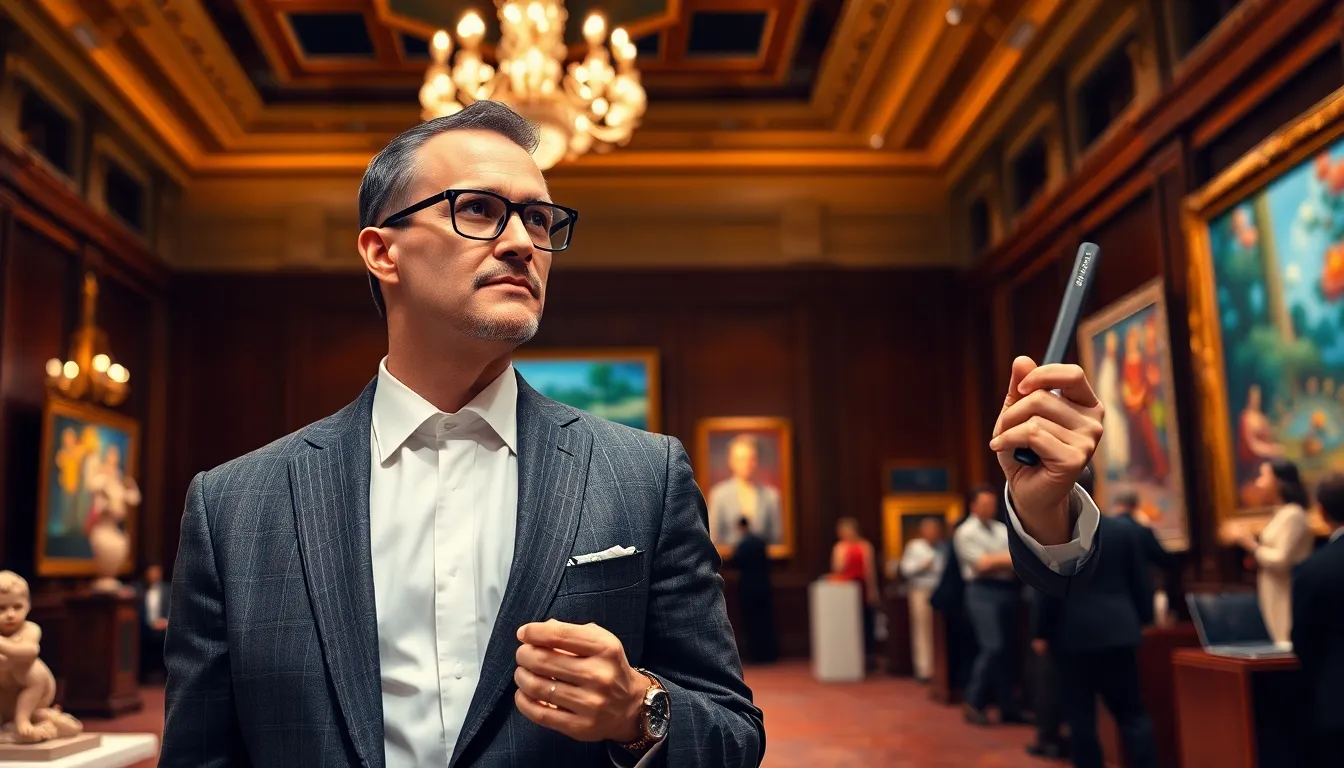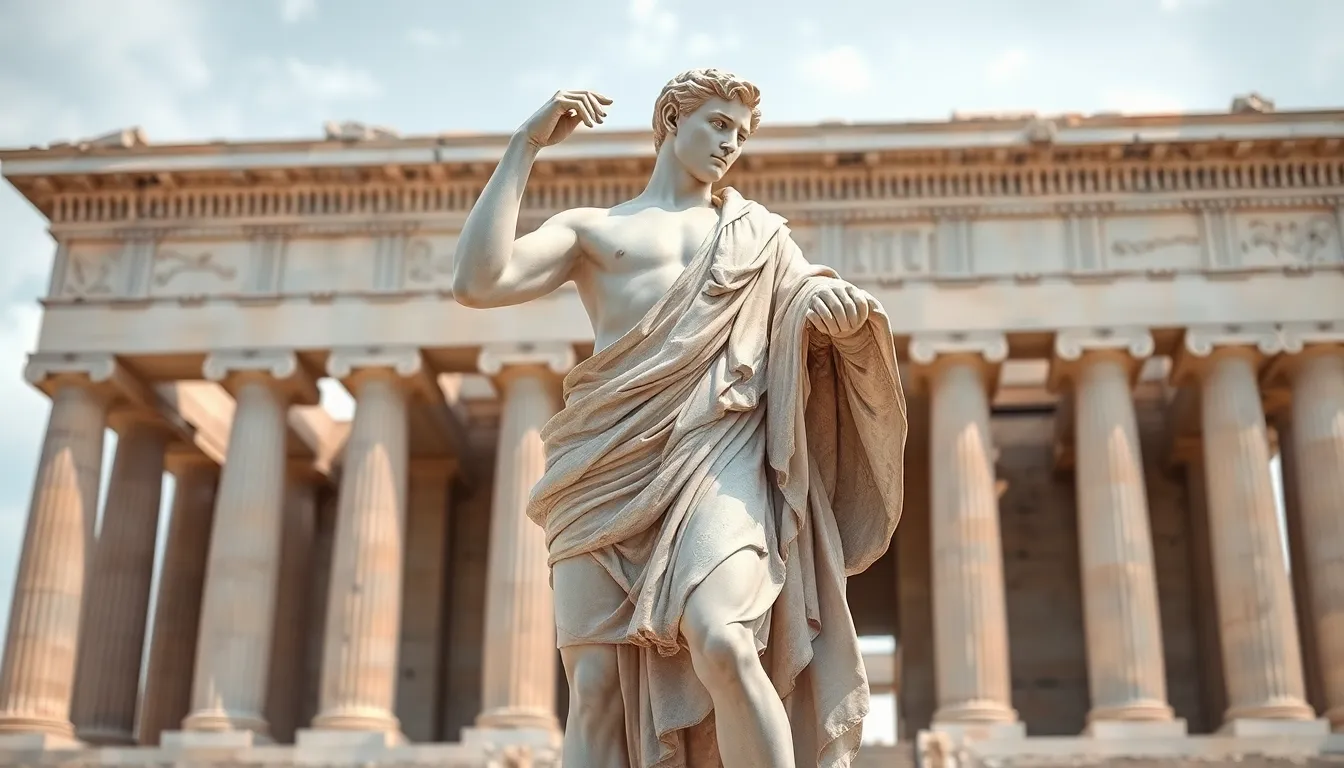High-end art auctions have become a thrilling spectacle where passion meets investment. These events attract collectors, investors, and art enthusiasts from around the globe, eager to acquire coveted pieces that often come with staggering price tags. The atmosphere buzzes with excitement as bidders compete for masterpieces that tell stories and reflect cultural significance.
In recent years, the art auction landscape has evolved, blending traditional practices with modern technology. Online platforms now offer unprecedented access to exclusive artworks, making it easier than ever for individuals to participate in the high-stakes world of fine art. Understanding the dynamics of high-end auctions not only reveals the allure of these events but also highlights the intricate relationship between art and wealth.
Table of Contents
ToggleOverview of High-End Art Auctions
High-end art auctions represent a significant intersection of cultural value and financial opportunity. Major auction houses, such as Christie’s and Sotheby’s, conduct these auctions, showcasing masterpieces from renowned artists. Auction events often feature artworks that fetch millions of dollars, attracting elite collectors alongside investors.
Bidders participate in these auctions to acquire exclusive pieces, such as rare paintings, sculptures, and other collectible art forms. The competitive environment fosters excitement, often leading to bidding wars with prices escalating rapidly. Data indicates that the global art market reached an estimated $50 billion in 2021, with high-end auction sales contributing a substantial portion.
The auction landscape has evolved, incorporating technology to facilitate online bidding and expand reach. Virtual platforms enable participants from various locations to engage in real-time bidding, transforming accessibility. As a result, buyers now access a wider array of artworks, all while remaining connected to global art trends.
Auction houses also provide provenance and expert appraisals, ensuring buyers understand the value of their investments. This transparency builds trust among bidders, reassuring them of the authenticity of the pieces. Additionally, comprehensive catalog descriptions enhance the purchasing experience, guiding collectors in making informed decisions.
Historical Context

High-end art auctions exhibit a rich history intertwined with cultural shifts and economic trends. The evolution of these events reflects significant influences on the art market and collector behavior.
Evolution of Art Auctions
Art auctions date back to ancient Rome, where they primarily served as a means to dispose of property. The format evolved through the centuries, with the first recorded auction house established in the 17th century in Amsterdam. By the 18th century, venues began hosting specialized auctions for artworks, significantly impacting how art was valued and sold. The 20th century brought notable advancements with the introduction of telephone bidding, expanding participation beyond geographical boundaries. Online platforms emerged in the 21st century, revolutionizing the auction landscape by providing instantaneous accessibility and fostering global bidding environments.
Iconic Auction Houses
Prominent auction houses play a pivotal role in shaping the high-end art auction scene. Christie’s, founded in 1766, is renowned for prestigious auctions that often highlight groundbreaking works. Sotheby’s, established in 1744, follows suit, offering significant sales and a broad range of fine art categories. Other notable firms, such as Bonhams and Phillips, contribute to the competitive market by hosting both traditional and contemporary art auctions. These auction houses symbolize trust and expertise, attracting elite collectors and investors while maintaining historical significance in the art world.
Key Players in High-End Art Auctions
High-end art auctions are dynamic, involving various key players that drive the market. Auction houses, collectors, and investors each have distinct roles that contribute to the excitement and financial implications of these events.
Auction Houses
Auction houses act as facilitators in high-end art auctions, connecting sellers with potential buyers. Major players include Christie’s, Sotheby’s, and Phillips, which have built reputations for their expertise and extensive networks. These houses provide critical services like cataloging artworks, appraisals, and establishing auction conditions. They often host exclusive events that showcase high-value pieces, drawing attention from international bidders. According to a 2022 report, Christie’s and Sotheby’s together commanded over 70% of the global auction market share. Their marketing strategies and reputation significantly influence market trends, attracting both emerging and established collectors.
Collectors and Investors
Collectors and investors play a central role in high-end art auctions. These individuals possess a keen interest in acquiring significant artworks, with motivations ranging from aesthetic appreciation to financial investment. Many notable collectors include billionaires and cultural figures, whose purchases often drive market prices upward. For instance, in 2021, a painting by Jean-Michel Basquiat sold for $41 million, demonstrating the impact collectors can have on the art market. Investors often seek artworks as alternative assets, viewing them as both a store of value and a means of diversifying portfolios. The interplay between collectors and auction houses shapes the trends and pricing within the high-end art scene.
The Bidding Process
The bidding process in high-end art auctions involves multiple stages, each crucial for securing desired artworks. Participants must navigate registration, utilize a paddle system, and develop effective bidding strategies.
Registration and Paddle System
Registration is mandatory for participation in high-end art auctions. Prospective bidders complete a registration form, providing personal details and financial information. This step ensures auction houses verify bidder identities and establish creditworthiness.
Following registration, each bidder receives a unique paddle number. This paddle serves as a personal identifier during the auction. Bidders raise their paddles to place bids, enabling auctioneers to track offers. The paddle system creates a sense of anonymity, allowing participants to focus on their bids without external pressures. Additionally, auction houses typically provide clear instructions on paddle usage to ensure smooth and efficient bidding.
Strategies for Bidders
Bidders employ various strategies to enhance their chances of winning desired artworks.
- Research Artwork: Bidders analyze auction catalogues and previous auction results. They gather information on artist reputation, market trends, and estimated values.
- Set a Budget: Bidders establish a firm budget before entering the auction. This approach preserves financial stability and prevents excessive spending driven by competition.
- Attend Previews: Bidders visit previews to inspect artworks closely. This allows them to assess quality and condition before bidding.
- Observe Bidding Patterns: Bidders observe the behavior of competitors during the auction. They identify patterns in bidding to better time their offers, potentially placing bids just before others to maximize chances of winning.
- Consider Timing: Bidders strategize their bids for key moments in the auction. Timing bids at the end can escalate competition, driving prices higher, or wait for quieter moments to place lower offers.
Employing these strategies significantly enhances bidder success rates while participating in the competitive atmosphere of high-end art auctions.
Trends in High-End Art Auctions
High-end art auctions are undergoing significant transformations driven by technological advancements and changing market dynamics. Understanding these trends provides insights into the evolving landscape of art collecting and investment.
Impact of Technology
Technology profoundly influences high-end art auctions, reshaping how enthusiasts and collectors engage. Online bidding platforms enhance accessibility, allowing participants from diverse geographical locations to compete in real-time. Major auction houses like Christie’s and Sotheby’s leverage these platforms for global reach, attracting a wider audience. High-definition streaming of auctions allows for a more immersive experience, while virtual previews of artworks enable informed bidding decisions. Technologies such as blockchain add an extra layer of security by ensuring the authenticity and provenance of artworks. As digital tools continue to evolve, they significantly enhance the overall auction experience, fostering greater buyer confidence and participation.
Growing Market Dynamics
The high-end art auction market reflects increasing demand, characterized by rising prices and heightened competition. In recent years, sales often surpass $100 million for single artworks, illustrating collectors’ willingness to invest substantial sums in coveted pieces. Emerging collectors, particularly younger generations, actively participate, driving fresh interest in contemporary artists and innovative works. Both private collectors and institutional investors recognize fine art’s potential as a durable asset class, contributing to continued market growth. The proliferation of art fairs and events also plays a significant role in energizing the auction scene, creating opportunities for networking and showcasing emerging talents. These market dynamics underscore a thriving environment that intertwines artistic passion with lucrative investment potential.
High-end art auctions represent a thrilling blend of culture and commerce. They offer a unique opportunity for collectors and investors to acquire extraordinary pieces while engaging in an exhilarating bidding atmosphere. The evolution of technology has made these auctions more accessible than ever, allowing a diverse range of participants to join in the excitement.
As the market continues to grow and adapt, the influence of younger collectors and innovative bidding strategies will shape the future of high-end art auctions. This dynamic environment not only highlights the intrinsic value of art but also underscores its potential as a lucrative investment. The ongoing interplay between passion and financial opportunity ensures that high-end art auctions will remain a focal point in the world of art and investment for years to come.





